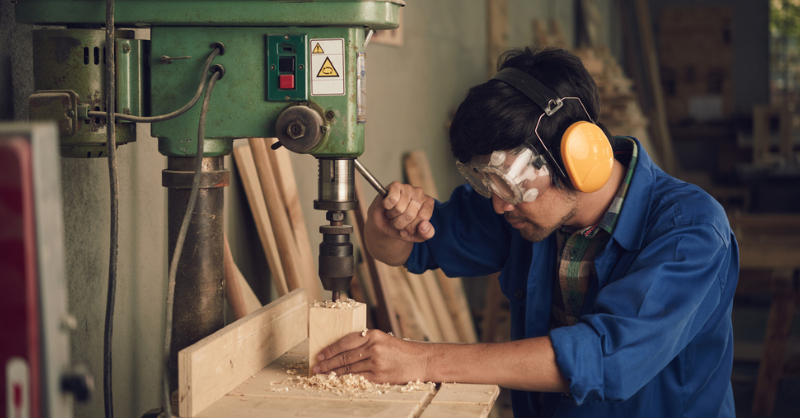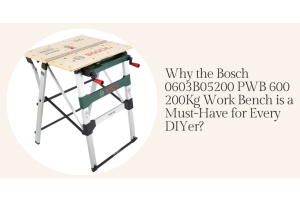How to Choose the Best Drill Press for Woodworking

The drill press has been around for over 100 years, and it was first developed in the late 19th century. It has undergone many improvements and advancements over the years, and today it is a sophisticated machine tool that is used in many industries.
What is a Drill Press?
A drill press is a machine used for drilling holes in various materials such as wood, metal, and plastic. It is a power tool that uses a rotating drill bit to create a hole in a workpiece. Choosing the right drill press for woodworking is essential because it affects the quality of the work and the safety of the operator. A suitable drill press can increase the accuracy and precision of the work and save time and money in the long run.
The drill press works by rotating a drill bit at high speed and using it to bore a hole in a workpiece. The drill bit is held in a chuck, and the workpiece is clamped to a table that can be adjusted up and down. The operator can adjust the speed and depth of the drilling, and there are various accessories and attachments that can be used to enhance the performance of the drill press.
Types of Drill Presses
Benchtop Drill Press/Bench Drill Press
Features and specifications
A bench drill press is a small, portable machine that can be placed on a workbench or table. It is ideal for small to medium-sized projects and can handle a range of materials.
Some common features of a benchtop drill press include:
- Motor horsepower: 1/4 to 1 HP
- Swing size: 8 to 12 inches
- Depth stop: Yes
- Stroke distance: 2 to 3 inches
- Digital readout: Optional
- Drill chuck capacity: 1/2 inch
- Worktable size: 8 to 10 inches
- Weight: 50 to 100 pounds
Pros:
- Affordable
- Portable
- Easy to use and store
Cons:
- Limited power and capacity
- Not suitable for large projects
- May vibrate and move during use
Floor Drill Press
Features and specifications
A floor drill press is a larger and more powerful machine that is designed for heavy-duty projects. It is typically mounted on a stand or base and can handle larger materials and thicker workpieces.
Some common features of a floor drill press include:
- Motor horsepower: 1 to 3 HP
- Swing size: 12 to 20 inches
- Depth stop: Yes
- Stroke distance: 4 to 6 inches
- Digital readout: Yes
- Drill chuck capacity: 5/8 to 3/4 inch
- Worktable size: 12 to 16 inches
- Weight: 200 to 500 pounds
Pros:
- Powerful and versatile
- Ideal for large projects and thick materials
- More stable and less likely to vibrate than a benchtop drill press
Cons:
- More expensive than a benchtop drill press
- Requires more space and may be difficult to move
- Not suitable for small or delicate projects
Important Rules for a Drill Press Machine
Safety precautions
- Always wear eye protection and ear protection when using a drill press.
- Keep loose clothing and long hair away from the drill bit and other moving parts.
- Keep the work area clean and free of debris to prevent accidents.
- Do not touch the drill bit or workpiece while the machine is running.
- Do not exceed the maximum drilling capacity of the machine.
Basic operations and maintenance tips
6. Read and understand the manufacturer's instructions before using the machine.
7. Use the appropriate drill bit and accessories for the material and project.
8. Keep the drill bit sharp and lubricated for optimal performance.
9. Clean and maintain the machine regularly to prevent damage and prolong its lifespan.
How to Use a Drill Press Machine Safely and Effectively
Preparing the workspace
- Ensure that the machine is properly set up and secured before use.
- Keep the work area clean and free of debris.
- Have a clear plan for the project and the desired drilling depth.
- Always wear eye protection and ear protection when using a drill press.
- Wear gloves and a face mask when working with certain materials, such as metal or plastic.
- Adjust the speed and depth of the drilling according to the material and project.
- Hold the workpiece firmly and use clamps or a vise if necessary.
- Use the depth stop to ensure consistent and accurate drilling.
Basic maintenance and cleaning
- Clean the machine after each use and lubricate the moving parts as needed.
- Check and tighten the bolts and screws regularly.
- Replace the drill bit and other accessories when worn or damaged.
The Most Common Uses for a Drill Press Machine
Woodworking applications
- Drilling holes for dowels, joinery, and hardware installation.
- Creating mortises and other specialized cuts.
- Sanding and polishing using sanding drums and buffing wheels.
Metalworking applications
4. Drilling holes in metal sheets and bars.
5. Tapping threads in metal components.
6. Deburring and chamfering edges using specialized bits and attachments.
Other applications
7. Drilling holes in plastic, ceramics, and other materials.
8. Engraving and carving using specialized bits and attachments.
9. Creating jigs and templates for accurate and repetitive drilling.
Features to Look For in a Drill Press Machine
- Choose a machine with enough horsepower to handle the materials and projects you will be working with.
- The swing size is the distance from the center of the chuck to the nearest edge of the column. Choose a machine with a swing size that can accommodate the size of the workpiece and the drilling depth you require.
- A depth stop allows you to set the drilling depth and ensures consistent and accurate drilling. Choose a machine with a depth stop that is easy to use and adjust.
- The stroke distance is the maximum distance the drill bit can travel up and down. Choose a machine with a stroke distance that is sufficient for the drilling depth you require.
- A digital readout allows you to monitor the drilling depth and speed more accurately. Choose a machine with a digital readout that is easy to read and use.
- The drill chuck is the mechanism that holds the drill bit in place. Choose a machine with a drill chuck that has a large enough capacity to accommodate the size of the drill bits you will be using.
- The worktable is the surface on which the workpiece is placed. Choose a machine with a worktable that is sturdy and can be adjusted to the desired height and angle.
- Choose a machine with a warranty that covers parts and labor for a reasonable period of time.
- Check the manufacturer's reputation and customer service record before making a purchase.
Factors to Consider Before Buying a Drill Press
- Determine how much you can afford to spend on a drill press. Consider the long-term value and the cost savings that a high-quality machine can provide.
- Determine how much space you have for the machine and whether it can be easily moved and stored. Consider the noise level and ventilation requirements of the machine.
- Determine the materials and projects you will be working with and choose a machine that is appropriate for those needs.
- Consider the frequency and intensity of use, as well as any special features or accessories that may be required.
Benefits of Owning a Drill Press
A. Increased accuracy and precision: It can help create straight and clean holes with minimal effort.
B. Versatility: The drill press can handle a range of materials and applications. It can be used for drilling, sanding, polishing, and other operations.
C. Time-saving: compared to hand drilling, It can perform repetitive drilling tasks more quickly and efficiently.
D. Cost-effective: The hand drill press can save money on materials and labor. It can reduce waste and errors, and it can be used for a variety of projects.
Conclusion
Selecting the ideal drill press for woodworking may appear overwhelming initially, but armed with the right knowledge and guidance, it becomes a rewarding and gratifying process. By carefully considering individual requirements, specific applications, essential features and specifications, as well as safety and maintenance considerations, individuals ranging from homeowners to DIY enthusiasts and professionals can discover the perfect drill press that aligns with their needs and budget. Prioritizing safety is paramount when operating a hand drill press, so it's crucial to adhere to the manufacturer's instructions and guidelines. Equipped with the appropriate drill press and accessories, drilling holes in various materials becomes effortless, yielding precise and accurate outcomes. Whether it's for hobby or professional use, a drill press serves as a valuable addition to any workshop or construction site.




